
King Penguins, Elephant Seals, & Fur Seals
From my perspective, South Georgia brought more dramatic experiences than the Antarctic Peninsula. During the two days we cruised off South Georgia, we stopped at several bays and rode zodiacs to shore in order to visit populations of Fur Seals, Elephant Seals, and King Penguins. Equally dramatic was a zodiac cruise at Drygalski Fjord.
Antarctic Fur Seal
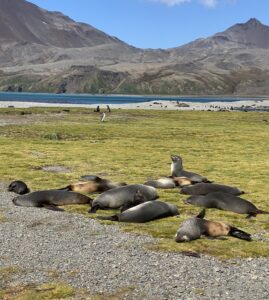
The dominant species on South Georgia is the Antarctic Fur Seal with a population estimated of between 4 and 6 million seals, which is about 90% of the world population. Adult fur seals can weigh 700 pounds
During the 18th and 19th centuries sealers almost destroyed the species in their quest of seal pelts that were made into ladies’ coats. The catch for a single summer was as high as 112,000. By 1822 the fur seal was nearly extinct on South Georgia. The quest for more seals motivated exploration of Antarctica and the southern ocean.
Today the fur seal population has recovered to the point that they are pushing out of their known traditional living areas. Since 2010 seals have pushed south to reach the southern side of Marguerite Bay. Another example is Signy Island in the South Orkney Islands. In 1977, the seal population was about 1600; in the mid-1990s it had grown to 20,000.
Seal migration poses ecological challenges for Antarctic vegetation. When a 700-pound seal hauls out onto land, coastal vegetation is trampled. The seals also defecate and urinate near freshwater lakes, polluting the water. Ecologists haven’t found a solution to this challenge yet.
Elephant Seals
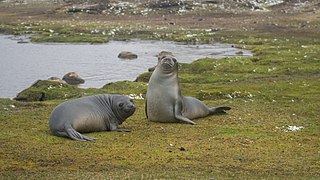
Half the world’s population of southern Elephant seals (Mirounga leonine) also lives in South Georgia with about 400,000 individuals coming ashore to mate.
Male elephant seals can dive to depths of 4600 feet and stay at that depth up to two hours. In October the males come ashore to fight over harems of females. The largest males are known as beach masters and can weigh up to 4 tons. I decided to enjoy them from a distance.
King Penguins
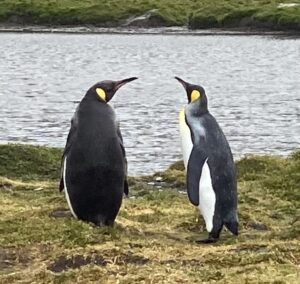
South Georgia is also home to King, Macaroni, Gentoo, and Chinstrap Penguins. Without a doubt, King Penguins are the star of the show. South Georgia has 450,000 pairs of breeding King Penguins, the largest population of King Penguins in the world. The birds grow up to 39 inches tall, and adults can reach a weight of 35 pounds.
The attraction of South Georgia is its proximity to the Antarctic Convergence where cold polar waters meets more temperate ocean water, and the waters are populated with squid, krill, and lantern fish.
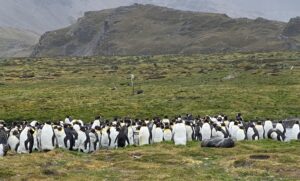
King penguins sport a coat of 70 feathers per square inch. There are three inner layers of down feathers for insulation, and outer feathers that are oiled and waterproof. Penguins shed all their feathers every year in a ‘catastrophic molt.’ It takes four weeks to replace their plumage which keeps the birds on land and hungry.

King Penguins also come on land to breed. Penguins are serially monogamous and lay their eggs in January. The female lays one two-pound pear shaped egg. The egg incubates for about 55 days. Rather then making a nest, King Penguins carry the egg in a warm fold near their feet. From the outside, it looks like the penguin is walking on its heels. It takes 14 months to raise a chick.
Whaling and sealing expeditions also threatened penguin populations on South Georgia. Lacking trees to cut for firewood, the hunters burned millions of penguins and used their oil and blubber to fuel fires they used to process the whales. The oil was also used for lamps, heating, and cooking.
Today, the King Penguin population thrives on South Georgia, which brings me to my Third Antarctic Lesson: Wildlife Recovery. To learn that the destruction and near extinction of whales, seals, and penguins in South Georgia and Antarctica did not result in their disappearance from our world is inspiring at a time when so many plants and animals struggle to survive. It is also humbling to realize that the greatest threat to biological species is human kind.
Drygalski Fjord
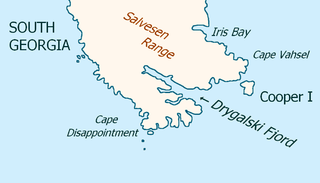
Drygalski Fjord is a mile-wide bay that recedes northward for 7 miles until it ends at Risting Glacier. The glacier is 4.5 nautical miles long and flows southeast into the head of Drygalski Fjord.
As we cruised on the surface, the silence and peacefulness of the fjord brought a sense of peace. We passed a seal resting on an iceberg. We encountered an iceberg with an unusual archway at the center but wisely did not approach too closely since we did not know how deep the ice extended. On the shore, the glacier calved. At one point, snowflakes fell on us. The experience was surreal and very different from the excitement generated by wildlife.



A video from a sail onboard the Scenic Eclipse gives some sense of what it was like to travel on the surface of the water in Drygalski Fjord.
🐧 🐧 🐧
Illustrations
Elephant seals on the Kerguelen Islands by Antoine Lamielle.
Penguin egg by Didier Descouens.
Map showing Dryglaski Fjord, South Georgia released to public domain.
Other Photos by Author.
Southern Elephant Seal, Gold Harbor, South Georgia. Smithsonian.
Sean Mowbray. “Fur Seals Made a Tremendous Comeback. That Might be a Problem.” The Atlantic. Dec. 2, 2022.

Sandra Wagner-Wright holds the doctoral degree in history and taught women’s and global history at the University of Hawai`i. Sandra travels for her research, most recently to Salem, Massachusetts, the setting of her new Salem Stories series. She also enjoys traveling for new experiences. Recent trips include Antarctica and a river cruise on the Rhine from Amsterdam to Basel.
Sandra particularly likes writing about strong women who make a difference. She lives in Hilo, Hawai`i with her family and writes a blog relating to history, travel, and the idiosyncrasies of life.

